
© Peter Muller.
Ballet Flamenco Sara Baras
Voces, Suite Flamenca
New York, City Center
5 March 2015
www.sarabaras.com
www.nycitycenter.org
Baras Pays Tribute to the Masters in Voces, Suite Flamenca
Flamenco shows tend to fall into one of three categories: intimate and free-form (Paco Peña, Soledad Barrio), experimental (Israel Galván, Rocío Molina) and concept-driven, with flashy light schemes, oceans of dry ice, and tightly-choreographed ensembles. The latter has become a rarity, in part as a result of the economic crisis in Spain. No more visits by Joaquín Cortés and a cast of thousands. Sara Baras’s new Voces, Suite Flamenca, currently at City Center, falls somewhere in between these three types: intimately scaled but highly choreographed and held together by an overriding theme. Baras is the undisputed star, at times joined by José Serrano or a small ensemble of six and backed by an excellent group of musicians and singers.
Voces is conceived as a tribute to past flamenco masters, whose profiles are depicted on large panels arrayed at the rear of the stage: we see the guitarist Paco de Lucía (who died last year), cantaor Camarón de la Isla, dancer Antonio Gades, etc. The evening is punctuated by recordings in which each doles out his own spin on flamenco philosophy. De Lucía speaks of the sea and of the hard work that lies behind inspiration, Gades about the need to transcend technique. Baras often faces the panels, gesturing toward them, even touching them.
Mainly, though, the subject of the show is Baras and her impressive technique, particularly in the area of zapateado, or percussive footwork, where she is an undisputed phenomenon. It seems unlikely that anyone in flamenco beats faster, with more clarity or dynamic contrast, than Baras. In solo after solo, the focus falls squarely on her feet; often she raises her skirt, as if to reveal the mechanics behind this great skill. Above the waist, little happens; another of Baras’s great talents is stillness, control. And she moves with spectacular speed – particularly in turns – never sacrificing clarity.

© Jullete Valtinedas. (Click image for larger version)
The problem is that this phenomenal skill often seems like an end in itself. As Gades says in his soliloquy: “we’re beginning to forget the reason why we dance; people used to dance to express a state of emotion.” (I’m translating loosely from the Spanish.) Baras is a perfect example of this tendency. Her dancing is spectacular but extremely contained, with little range of emotion or spatial freedom. Nor is the choreography she creates for herself particularly varied, with the exception of the intricacies of the footwork. Every solo becomes a demonstration of this virtuosic ability. The most engrossing passage in Voces is a rhythmic conversation between Baras and one of her musicians on the tambourine. It is a farruca (usually danced by men). As in an Indian kathak recital, the percussionist tapped out a rhythm, to which she responded with her feet. Back and forth they went, adding complexities, accents, and syncopations. Rhythm is Baras’s playground, and here she can set her imagination free.
For most of the evening, Baras danced alone, but she also shared a tightly-choreographed duet with José Serrano, a dancer with a strong, resounding and similarly precise style. Later in the evening Serrano had his moment in the sun, a soleá, accompanied by Israel Fernández, whose stirring, almost androgynous voice brought to mind the call to prayer of the muezzin. Serrano cut loose only at the very end: suddenly, he was full of tricks, off-kilter glides, syncopated jokes. If only this spirit of mischief had made itself known a bit earlier, the night might have gotten off to a better start.
In between, the ensemble of six did some boilerplate flamenco corps-work. There was a rather unfortunate re-enactment of the stabbing scene from Carmen, accompanied by a jazzy pre-recorded arrangement of Bizet. (There were several of these jazzy interludes.) A shirtless toreador made an appearance, carrying an enormous red cape, and then disappeared, never to be seen again.
Throughout, the excellent guitarist Keko Baldomero – who composed and arranged much of evening’s music – played with a singing, rich tone, sometimes accompanied by another guitarist, Andrés Martínez. Baras changed her look several times, displaying a remarkable sense of style. She’s petite, athletic, sleek. The first dress was tight and simple, black with white polka dots; the second, which looked at first like a Roman peplum, unwound into a flowing tunic that became an aureole of illuminated fabric as she turned (à la Loie Fuller). For the farruca she donned slim trousers and top, both black. And for the finale, a spectacular green dress with three layers of fringe that danced with her every move. But, as the flamenco masters might have said, style and virtuosity can only get you so far.









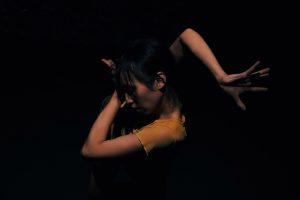
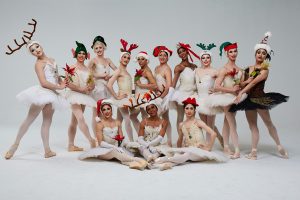
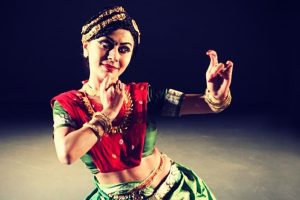

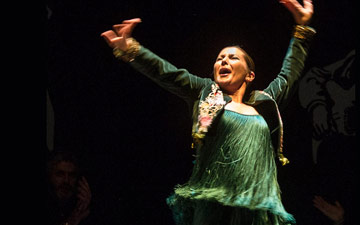
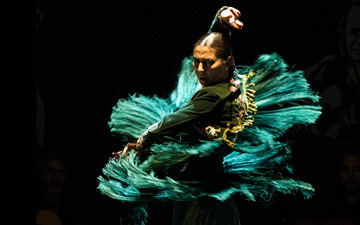

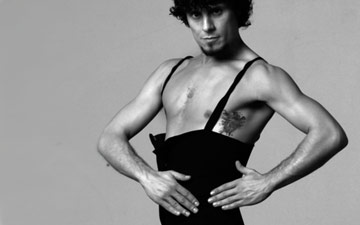
[…] A Loie Fuller moment in Sara Baras’s Voces, Suite Flamenca, currently at City Center. You can see my review here. […]
I have dedicated my life to painting both the flamenca dancers and ballerinas. I am very interested in being able to conatact both photographers Peter Muller and Jullette Valtinedas. Rerspectfully Jay Johansen USA
Afraid we have had no contact with the photographers. The pictures will be from the theatre/promoters and we link to the theatre and to the Baras website at the top of the review.